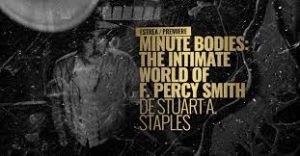This gallery in Bushwick had an art installation with a giant painting that dragged on the floor, complete with slippers to walk onto the painting so you could get even closer. It was a Friday night and there were lots of people talking loudly. I was reading the artwork’s description when I read that she also made video art, and low and behold behind a crowd of people was a puny flat screen on the wall playing a 24 min video on loop. The video clearly had dialogue, but the poor speakers were nothing for the mass of people, so I tried to gather as much as I could from the visuals. I never grasped the story without the dialogue, which makes me consider all of the considerations for gallery video art. The imagery without dialogue or context felt like a random assortment of imagery to just be weird. There was a sterile hospital environment with workers working by themselves wearing colorful experimental or futuristic clothing. One person on a typewriter was eating candy and getting scolded for something. In another scene, it appeared to be some sort of control room where everyone still wore the same type of clothes but with old computer keyboards and a girl dancing on a pole. There was some tension that broke out, but without dialogue it was unintelligible. Overall, it was a let down because of the sound, and I would like to hear it in another context, like youtube!
Author: Cory
Emissary Forks at Perfection (2015-6) by Ian Cheng

The first line of the description for this video art installation is “a video game that plays itself.” It plays live like an infinite dream sequence of Talus Twenty Nine, an artificial intelligence being who oversees the terrain. Each time the program is run, something different happens, much like the spontaneity of a human life.
The ongoing nature of the algorithm shows how AI can be programmed to interact in a way like humans, but feels ultimately repetitive and limited. Although the sequence was different every time the program is run, it was still the same ingredients all senselessly interacting. It serves the gallery space well because it can be something to ponder for a moment then carry on, still mostly absorbing the piece. I felt that after 12 minutes it was starting to feel like I wanted to move on. Using AI and technology to help humans process data, numbers, and store things makes sense to me, but teaching computers to do human things like dreaming and imagining seems dangerous and, at this point, way inferior than our own imaginations. What was lacking in the work was any semblance of a narrative, and so it could never feel truly human, but should we be trying to build technology that is as human as us?
Minute Bodies: The Intimate World of F. Percy Smith by Stuart Staples

On April 4th at 10:30pm, Metrograph showed Minute Bodies (2016) as part of its late night series. While I was worried that I would fall asleep to a wordless, conceptual piece so late in the evening, the lively jazz music paired with an intimate peek at the microscopic and macroscopic natural world kept me in awe of the patterns, shapes, and forms that are apparent at every amplitude of nature.
With much of the time-lapse video showing the growth and movement of various organisms, such as roots, sprouts, spores, shoots, flowers, frogs, and ants, I saw the dance of nature in all its subtle, time-less glory.
I know very little about F. Percy Smith, but this homage to his work convinces me to investigate further. In the credits, I saw that his documentaries number in the dozens! This documentary was made by Stuart Staples to pay homage to the work of F. Percy Smith. This narrative, if you can call it that, was as chaotic and spontaneous as nature. But evident in the spontaneity are the rhythms that flow from it. The music of the film utilized various instruments, but always seemed to match the intuitive, improvisational style in jazz, which only emphasized the infinite patterns of nature.
The audience seemed to be awake and actively watching the film, especially because the theater was giving out all their popcorn for free since they were going to throw away at the end of the night. I heard the constant chewing of popcorn as well as the occasional gasp or giggle at the funny interactions on the screen,
The film is a short 55 minutes, but gives you enough time to really settle into it. At what would be the climax, there is an overlay of time-lapse growth scenes that replicates fireworks as foliage and mold spray and spew in networks so fast with the music that it is almost a celebration of life in the natural world. Overall, I found this film to be inspirational!